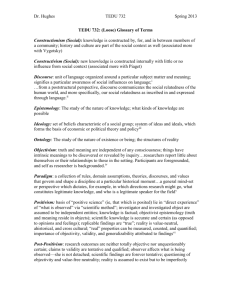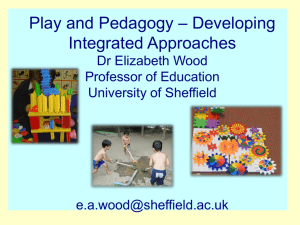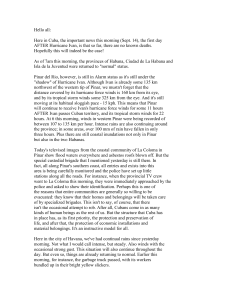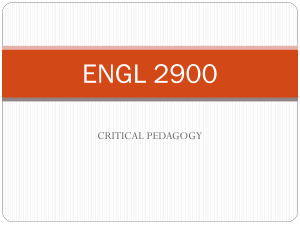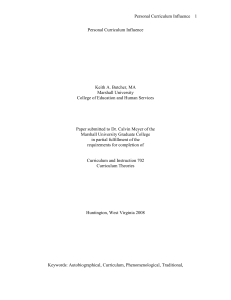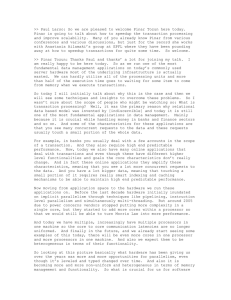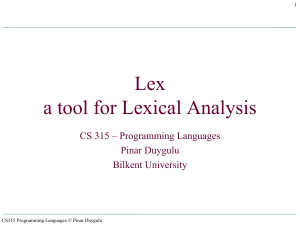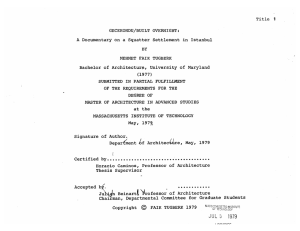Comprehensive03 - Simon Fraser University
advertisement
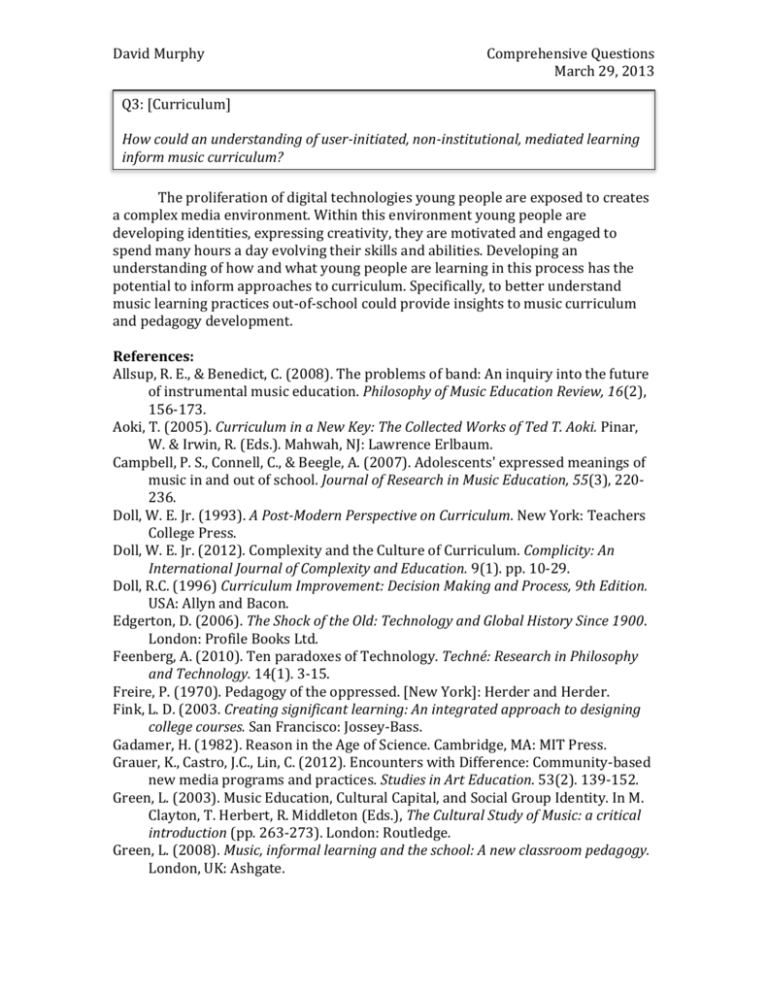
David Murphy Comprehensive Questions March 29, 2013 Q3: [Curriculum] How could an understanding of user-initiated, non-institutional, mediated learning inform music curriculum? The proliferation of digital technologies young people are exposed to creates a complex media environment. Within this environment young people are developing identities, expressing creativity, they are motivated and engaged to spend many hours a day evolving their skills and abilities. Developing an understanding of how and what young people are learning in this process has the potential to inform approaches to curriculum. Specifically, to better understand music learning practices out-of-school could provide insights to music curriculum and pedagogy development. References: Allsup, R. E., & Benedict, C. (2008). The problems of band: An inquiry into the future of instrumental music education. Philosophy of Music Education Review, 16(2), 156-173. Aoki, T. (2005). Curriculum in a New Key: The Collected Works of Ted T. Aoki. Pinar, W. & Irwin, R. (Eds.). Mahwah, NJ: Lawrence Erlbaum. Campbell, P. S., Connell, C., & Beegle, A. (2007). Adolescents' expressed meanings of music in and out of school. Journal of Research in Music Education, 55(3), 220236. Doll, W. E. Jr. (1993). A Post-Modern Perspective on Curriculum. New York: Teachers College Press. Doll, W. E. Jr. (2012). Complexity and the Culture of Curriculum. Complicity: An International Journal of Complexity and Education. 9(1). pp. 10-29. Doll, R.C. (1996) Curriculum Improvement: Decision Making and Process, 9th Edition. USA: Allyn and Bacon. Edgerton, D. (2006). The Shock of the Old: Technology and Global History Since 1900. London: Profile Books Ltd. Feenberg, A. (2010). Ten paradoxes of Technology. Techné: Research in Philosophy and Technology. 14(1). 3-15. Freire, P. (1970). Pedagogy of the oppressed. [New York]: Herder and Herder. Fink, L. D. (2003. Creating significant learning: An integrated approach to designing college courses. San Francisco: Jossey-Bass. Gadamer, H. (1982). Reason in the Age of Science. Cambridge, MA: MIT Press. Grauer, K., Castro, J.C., Lin, C. (2012). Encounters with Difference: Community-based new media programs and practices. Studies in Art Education. 53(2). 139-152. Green, L. (2003). Music Education, Cultural Capital, and Social Group Identity. In M. Clayton, T. Herbert, R. Middleton (Eds.), The Cultural Study of Music: a critical introduction (pp. 263-273). London: Routledge. Green, L. (2008). Music, informal learning and the school: A new classroom pedagogy. London, UK: Ashgate. David Murphy Comprehensive Questions March 29, 2013 Gouzouasis, P. (2010). An ethos of music education in the 21st century: A (im) possibility? Presented at: May Day Group 22nd Colloquium. Montclair State University. Montclair, NJ. June 17-20, 2010. Heidegger, M. (1977). The question concerning technology. In The question concerning technology and other essays (pp. 3-35). New York: Harper Textbooks. Irwin, R. L., O’Donoghue, D. (2012). Encountering Pedagogy through Relational Art Practices. International Journal of Art & Design Education. 31(3). 221-236. Knight, P. T. (2001). Complexity and curriculum: a process approach to curriculummaking. Teaching in higher Education, 6(3), 369-381. Null, J. W. (2008). The SAGE Handbook of Curriculum and Instruction. Connelly, F.M., Ming, F., Phillion, J. (Ed.). Los Angeles: Sage. Piaget, J. (1985). Equilibration of Cognitive Structures: The Central Problem of Intellectual Development. Chicago, Il: University of Chicago Press. Pinar, W. F. (1975). Curriculum theorizing: The reconceptualist. Berkeley, CA: McCutchen. Pinar, W. F., Reynolds, W. M., Slattery, P. G., Taubman, P. M. (1995). Understanding Curriculum. New York: Peter Lang. Pinar, W. (2004). What is curriculum theory? Mahwah, NJ: Lawrence Erlbaum. Pinar, W. (2008). The SAGE Handbook of Curriculum and Instruction. Connelly, F.M., Ming, F., Phillion, J. (Ed.). Los Angeles: Sage. Pinar, W. F. (2012, July 13). The First Task of Thought in Our Time. Paper presented to the University of British Columbia - Simon Fraser University Institute on the Recurring Questions of Technology, held on the UBC campus. Schafer, R. M. (1976). Creative Music Education: A Handbook for the Modern Music Teacher. New York, NY: Macmillan. Schafer, R. M. (1986). The Thinking Ear: On Music Education. Douro-Drummer, Ont: Arcana Editions. Schafer, R. M. (1992). 100 Exercises in Listening and Soundmaking. DouroDrummer, Ont: Arcana Editions. Smith, P. L., & Ragan, T. J. (2005). Foundations of Instructional Design. In, Instructional Design. New Jersey: John Wiley & Sons Inc. pp. 17-37. Söderman, J. & Folkestad, G. (2004). How hip-hop musicians learn: strategies in informal creative music making. Music Education Research, 6(3), 313-326. Truax, B. (1992). Musical Creativity and Complexity at the Threshold of the 21st Century. Journal of New Music Research. 21(1). 29-42. Truax, B. & Barrett, G. W. (2011). Soundscape in a context of acoustic and landscape ecology. Landscape Ecology. 26(9). 1201-1207. Trueit, D. (2005). Complexifying the Poetic: Toward a poiesis of curriculum. Louisiana State University Doctoral Dissertation. Tyler, R. W. (1949). Basic principles of curriculum and instruction. Chicago: University of Chicago Press. Väkevä, L. (2010). Garage band or GarageBand®? Remixing musical futures. British Journal of Music Education, 27(1), 59-70.
